How reverse osmosis works: the principle of operation of fine water purification devices
Among household systems for preparing drinking water for consumption, a new option has recently appeared, which is called reverse osmosis.This set of filters and a special membrane costs a lot, but can give odds to almost any analogue.
Does it make sense to fork out more? To answer this question, you need to find out how reverse osmosis works, and then compare the costs and results. With our help, the process of becoming familiar with the advanced treatment system will go much faster and more efficiently.
We have collected and systematized for you all the useful and reliable information about the membrane water treatment plant. To complete the perception, we supplemented the text material with diagrams, illustrations and videos with recommendations for future buyers.
The content of the article:
Operation of reverse osmosis installation
The process of osmosis is based on the property of water to equalize the level of impurities in solutions separated by a membrane. The holes in this membrane are so small that only water molecules can pass through them.
If the concentration of impurities in one part of such a hypothetical vessel increases, water will begin to flow there until the density of the liquid in both parts of the vessel is equalized.
Reverse osmosis gives exactly the opposite result. In this case, the membrane is used not to equalize the density of the liquid, but to collect clean water on one side, and a solution maximally saturated with impurities on the other. That is why this process is called reverse osmosis.
All these chemical features are of little interest to buyers, especially those who are not very well versed in science.It is enough for them to understand that the center of the reverse osmosis system is a special membrane, the pores of which are so small that they do not allow anything larger than the size of a water molecule to pass through, and this is a significant part of the contaminants contained in tap water.
Alas, the water molecule is not the smallest on earth; for example, chlorine molecules are much smaller, so they can also leak through the membrane. In addition, contact with large suspensions is contraindicated for this membrane. Its small pores will quickly become clogged with such exposure, and this element will have to be replaced immediately.
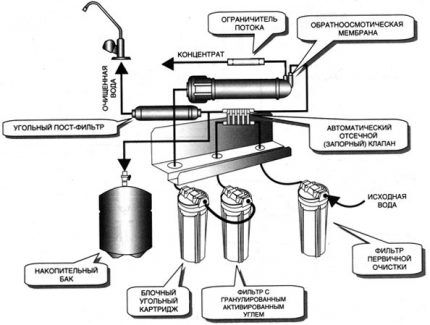
To prevent this from happening, the reverse osmosis system also includes three additional filters, with the help of which water undergoes preliminary preparation. The membrane divides partially purified water into two unequal parts. Approximately a third of the incoming volume is clean water, which then enters the storage tank.
Another two-thirds of the water volume is the part in which contaminants are concentrated. This concentrate is discharged into the sewer. There is usually a small container between the tank and the tap. A cartridge is installed here, which is designed to improve the quality of already purified water, for example, to saturate it with useful minerals.
Schematically, the principle of reverse osmosis can be described as follows:
- Water comes from the water supply system to pre-filters.
- The liquid then goes through a reverse osmosis procedure.
- Purified water enters the storage tank.
- The concentrate containing filtered contaminants is transported to the sewer.
- Clean water from the storage tank flows to the clean water tap directly or through additional devices.
Thus, a reverse osmosis system is a set of devices that provide the ability to obtain drinking water with a high degree of purification. Until recently, such systems were used mainly in industry, catering establishments, health institutions, etc.
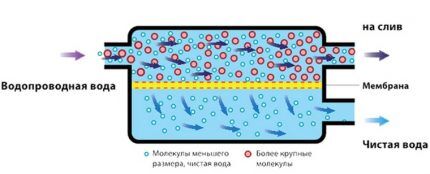
But due to growing requirements for the quality of tap water, in recent years reverse osmosis systems designed for domestic use have become increasingly popular. They differ in configuration, performance, storage capacity sizes, etc. Filters and membrane need to be replaced periodically.
How to determine that the membrane needs to be replaced? As it is used, its pores become clogged, and there comes a time when water simply does not pass into the storage tank. Such a membrane will have to be replaced in any case. But experts recommend replacing it much earlier.
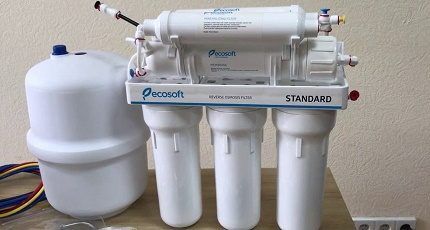
To determine the quality of water purified using a reverse osmosis system, an electronic device is used - TDS-meter. It is used to determine the level of salt content in water.
For tap water before purification, this figure can be 150-250 mg/l, and after purification using reverse osmosis technology, the salt content is considered to be within the range of 5-20 mg/l. If the amount of salts in purified water is more than 20 mg/l, it is recommended to replace the membrane.
Those wishing to select water filters used in various stages of purification will find a lot of useful information in the next article.
Individual elements of the system
The most expensive and basic element of a reverse osmosis system is the membrane. It is a microporous material twisted into one or more layers around a perforated plastic core. The membrane is covered on top with a plastic protective cover, which is secured with O-rings.
Water enters the membrane body and passes through the porous filler. In this case, pure water molecules penetrate through the porous core and then move into the storage tank.
But contaminants with a certain amount of water cannot overcome the membrane barrier. They exit the opposite end of the membrane block and are disposed of.
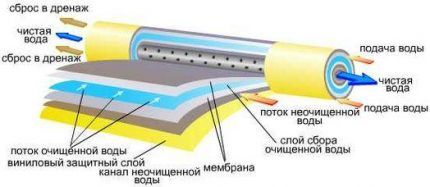
As previously mentioned, direct contact of the membrane with ordinary tap water can be harmful. The fact is that its pores are very small - only 0.0001 microns. The membrane cannot be removed, washed and reinstalled, as is done with some mechanical coarse filters.
An expensive element has to be completely replaced every two to three years.The period may vary depending on the operating conditions of the membrane: pressure in the water supply system, the amount and nature of contaminants, water temperature, etc.
In some cases, the membrane can last five years or even longer, but sometimes it has to be replaced after the first year of operation.
An important factor in this case is the presence of pre-cleaning filters: two mechanical and one carbon. The first mechanical filter cuts off all insoluble contaminants larger than 0.5 microns. These could be grains of sand, particles of rust and other similar “mechanics”.
The water then passes through carbon filter, which retains molecules of various chemicals: chlorine compounds, which are invariably present in tap water, as well as heavy metals, pesticides penetrated from the soil, dissolved iron and other inclusions of organic or inorganic origin.

After this, another mechanical one-micron filter completes the preliminary purification of the water. As a result, the membrane receives water that does not contain contaminants that could damage membrane filter or overcome it.
These filters need to be replaced regularly every few months. But they cost several orders of magnitude cheaper than a membrane, and timely replacement can significantly extend its service life.
A storage tank is used to collect purified water. Its capacity can vary between 4-12 liters, it depends on the performance of the system. High quality steel is usually used to produce such tanks. The outside of the container is covered with a layer of durable enamel. A silicone gasket is installed inside, which divides the tank into two parts.
On one side of the gasket there is collected clean water, on the other there is air. The amount of air in the chamber can be changed using a nipple located on the air side of the tank.
The air creates additional pressure inside the storage tank, which helps move water to the tap with the required pressure. Of course, the tank has an outlet for connecting a hose through which drinking water moves to the tap.
Typically this faucet is installed at the sink. Even if the water supply through the water supply is stopped for some reason, some amount will remain in the tank, which will make the problem less acute. In this situation, to completely empty the storage tank, it makes sense to increase the pressure by pumping air through the nipple connection.
The degree of water purification using a reverse osmosis system brings it closer to distilled water. At the same time, the membrane allows oxygen molecules dissolved in water to pass through, which improves its quality.
To improve the taste, water can be passed through a mineralizer or other modules. But it is suitable for drinking immediately after undergoing membrane cleaning. There is no need to boil it for drinking.
As an additional module that improves the quality of drinking water, reverse osmosis systems can be supplemented with a mineralizer or bioceramic cartridge. The mineralizer is used to enrich water with useful substances such as calcium, sodium, magnesium, etc.
All these minerals have a positive effect on the human nervous and cardiovascular systems, prevent the occurrence of many dangerous diseases, stimulate normal levels of blood acidity, etc.
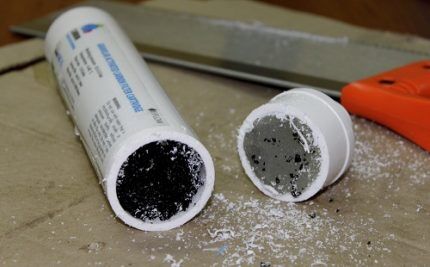
The bioceramic cartridge works differently. Its “filling” contains balls consisting of baked clay and pieces of tourmaline. This mineral can have an extremely beneficial effect on water. It helps change the structure of water, which ultimately has a beneficial effect on the endocrine system and strengthens the immune system.
Over time, the resource of such additional modules is exhausted and they require periodic replacement. Therefore, it is more convenient to use a tap with two valves.
One valve is supplied with water directly from the storage tank, and the second valve is supplied with water that has passed through the mineralizer.Water enriched with useful substances is used only for drinking, and is prepared with water without minerals.
One of the popular articles our site.
Advantages and disadvantages of reverse osmosis
A high degree of purification and guaranteed quality of drinking water are the main advantages of reverse osmosis systems. It is estimated that the content of foreign substances in water purified by this method is ten times lower than the minimum permissible standard. The design features of the membrane prevent the accidental entry of contaminants into the purified water flow.

This water can be safely used for drinking and cooking; it can be given to children and pets. For health, water obtained using reverse osmosis technology is much healthier than boiled tap water. Aquarists use this water to supplement the volume of aquariums without settling.
Despite the more complex design compared to conventional household filters, installation of such systems runs without any problems. Everything needed for installation is usually included in the kit. Almost all elements or their modifications can be purchased separately.
The system does not take up too much space; most often the tank and a set of filters with a membrane are fixed directly under the sink. A compact drinking water tap installed on the sink usually fits perfectly into the interior.
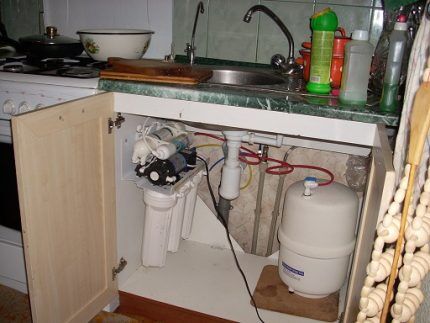
The main disadvantage of reverse osmosis systems is the high initial cost of the kit. Further maintenance of the system will also require the cost of replacing filter cartridges, but they cost significantly less.
Every few years you will have to replace the membrane, the price of which can be about $50. But calculations show that as a result, the cost of clean water will still cost the family less than purchasing drinking water from third-party suppliers.
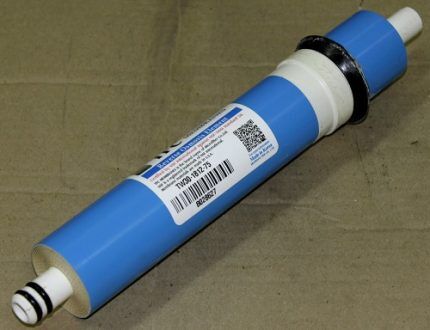
Another feature of the reverse osmosis system, which at a stretch can be considered a disadvantage, is low productivity. Purified water percolates through the membrane very slowly; the standard membrane capacity is about 150-300 liters per day.
At the same time, more than half of the water coming from the water supply goes into the sewer system, which to some extent affects the amount of utility bills.
But if the volume of the storage tank is selected correctly, then problems may arise for a short time only when starting the system immediately after installation or after a long period of inactivity with the storage tank empty.
We recommend an article on the topic: Reverse osmosis: harm and benefits of membrane purification of tap water.
How to choose the right model?
The dimensions of the elements of reverse osmosis systems usually correspond to a certain standard, but not always. Using a system with standard parameters provides a wider selection of replaceable elements. Practice shows that domestically produced products, which are cheaper than their foreign counterparts, are not much different in quality from the latter.
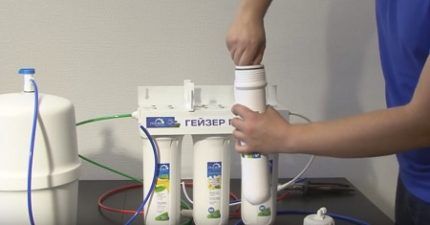
Of course, it is better to make a purchase directly from the manufacturer, from a verified dealer or from a reliable store. Good reverse osmosis systems have a technical passport, an official guarantee, detailed installation and operating instructions, as well as quality certificates.
The size of the storage tank depends on the needs of the family, as well as on the size of the space in which the device will be installed. A container of the maximum size will be appropriate for a house in which a large family lives; tanks with a volume of about 8-10 liters are considered the most popular.
An important indicator is working pressure in the water supply system. The optimal value is 2.8 bar.If the pressure is too low, it makes sense to buy a reverse osmosis system with a built-in pump, which will provide sufficient pressure for drinking water. If the pressure in the water supply is much higher, you will need to install a pressure reducer.

The membrane of the reverse osmosis system requires the closest attention. This element must be of consistently high quality and suitable performance. For a small family, the optimal figure is about 7 liters per hour.
It makes no sense to overpay for a more efficient membrane if it is not needed. For comparison, a device with a capacity of 15 liters per hour can easily satisfy the clean water needs of a small catering establishment.
A standard set is considered to include five main stages of purification: three pre-filters, a membrane and a post-filter. The content of this last element may vary.
The mineralizer and bioceramic cartridge were already mentioned earlier. A popular solution is also considered to be installing a cartridge containing coconut shells, activated carbon and silver ions.
These substances disinfect water, further purify it and give it a pleasant taste. Another interesting water post-treatment option is an ultraviolet disinfectant. Some models of reverse osmosis systems allow you to use several different cartridges at the same time.
Conclusions and useful video on the topic
Video #1. A general overview of the operating principles of reverse osmosis systems can be found here:
Video #2.This video describes in detail the operation of such a system using the example of the Geyser Prestige M model:
Video #3. This video allows you to compare the operating features of flow filters and reverse osmosis systems:
Reverse osmosis systems are a reliable and convenient way to provide your home with enough clean drinking water. Yes, the prices for such devices remain high, but they more than pay for themselves, since clean drinking water reduces the risk of many diseases and improves the quality of life.
Would you like to talk about your personal experience in installing and operating a reverse osmosis system? Do you have information that you would like to share with us and site visitors? Do you have any questions? Please leave comments in the block located below the text of the article.




Two years ago I decided to purchase a water filter. And I decided to go online to see which one is better to choose. My God, how much information came crashing into my head. The price was not a problem for me. I wanted to buy one with reverse osmosis, but they say it produces distilled water. It scared me away. I bought regular Aquaphor. Now I'm thinking again.
I still remember how I chose a water filter. There was no exact information anywhere: which is better and which is worse. Some said that reverse osmosis is a scam to get more money. I thought a lot about whether to buy it or not. And then it turned out that I didn’t have enough space under the sink, and this made my choice easier. Therefore, I took a regular, inexpensive filter, which I still use every day.
This is the second year I have been using Aquaphor Osmo 50. The water is clean and tasty. There is no scale in the kettle at all.
Happy as an elephant.
Damn, you said something about 50 bucks.Maybe this is some kind of expensive membrane model? Seriously, I saw the same aquaphor on sale for 1500. And by the way, some people’s water is so bad that they change this membrane once a year.
Yes, indeed, the frequency of membrane replacement directly depends on the quality of the water. The price of this item depends on the model. It is clear that in a $200 system the membrane will not cost $50. But in a $1000+ reverse osmosis system this may well be the case. So in this regard, not everything is so simple.
Quote: “For health, water obtained using reverse osmosis technology is much healthier than boiled tap water.”
Oh ba. You don’t even understand what you’re writing. What usefulness of boiled, distilled water can we even talk about? Good health and boiled water are NOT compatible things. When boiled, water changes its crystalline structure completely - it is DEAD water. Drinking boiled water completely kills your immunity. Everyone who drinks only boiled water has a bunch of chronic diseases, complications of the WHOLE body and does not understand the reason why they get all this.
Have you seen enough films on REN TV? Or the same film supposedly from the Japanese about the wonders of water? It has long been refuted that all this is not scientifically substantiated.
However, in some ways you are right. Drinking completely pure water is not good. For example, those same tourists who go hiking in winter and melt snow as water should always take electrolytes and mineral supplements in powders with them. Because you can’t live long on melted snow and you can seriously damage your health.
Another point is that often various “enrichment agents” are installed in filtration systems - mineralizers, which serve precisely these purposes. It’s just important to study everything completely in advance so as not to be poisoned later. After all, no one will check on you to see what you drink there.
Doesn't it seem ridiculous to you that boiled water is “dead”? This automatically means that we consume food and drinks prepared with “dead” water! This is far from true!
Many also talk about distilled water and purified water using reverse osmosis. But there is no need to mislead people, purified water does not contain impurities and is absolutely safe. Yes, it does not contain minerals and salts, but the human body can get all this from other foods.
Crystalline structure is found only in solids.
Normal system, the water is of course super. You can make it ice cold in the refrigerator, in clean containers, of course, and there won’t be any sore throat - it’s sterile.
So it’s bacteria and viruses in ice water that give us a sore throat...)
“The main disadvantage of reverse osmosis systems is the high initial cost of the kit”... A controversial statement. Health is more important!
The main drawback of such systems is the inability to restore the optimal balance of salt content even with the help of mineralizers (see attachment). And without salts of general hardness (Ca2+ and Mg2+ ions) we will be in a bad place. Over time, osteoporosis will appear, etc.
P.S. Since I am an analytical chemist, after purifying the water in a system with a mineralizer, I immediately did an analysis for total hardness: the result was <0.02 mEq/l, i.e. practically a distillate.The physiological norm according to SanPin for packaged water is at least 1.5 mEq/l (see file).
We moved to the village and installed purification with osmosis. But the water consumption is appalling. In a month, a full septic tank is 10 m3. Two thirds of the water is drained.
Of course, I want to drink clean water and for cooking, too, but I don’t see the point in bothering with osmosis. The usual triple purification is already good, but with osmosis, then a spacesuit with oxygen cylinders and domed fields like greenhouses, etc. You will purify the water to a very good level in others places (food, atmosphere, household chemicals and a lot of things) you will pick up poison, you won’t be able to hide from it anywhere, but drinking clean water and triple cleaning is normal without any problems, change the cartridges in a timely manner, that’s all.
I watched 2 videos and remembered a fairy tale about how a soldier cooked porridge from his boot. What about chlorine? I don’t know whether the membrane is afraid of it or not, but the chlorine molecule is smaller than water and this protection is not a hindrance to it. And second. If only everything in nature were so simple. I ate or steeped a pebble in water and replenished the minerals. And it has not been proven that minerals from water are absorbed by the body and in what quantities. So it’s better for the consultant not to touch this topic, especially when he skipped chemistry classes. And one last thing. If you have the means. It is better to drink purified water than a mixture of iron, manganese and all sorts of things